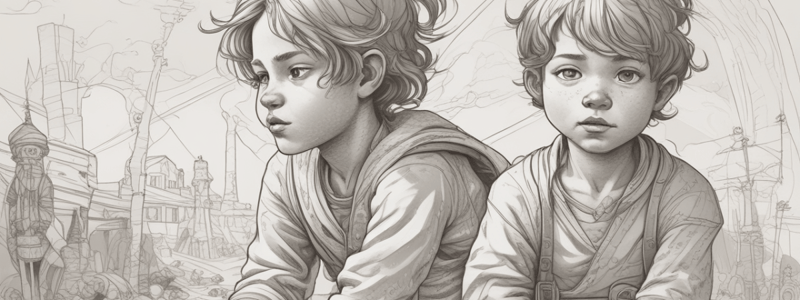Podcast
Questions and Answers
What is the most frequent criteria cited by children in a questionnaire?
What is the most frequent criteria cited by children in a questionnaire?
- Opportunity for free play
- Decline in the opportunity for free play
- Inferred Intention from Action
- Facial expression (correct)
What is a benefit associated with engaging in play fighting?
What is a benefit associated with engaging in play fighting?
- Enhanced socio-cognitive skills (correct)
- Reduced social skills
- Decreased executive functions
- Increased anxiety and depression
What impact does enforced play deprivation have on children undergoing long-term hospitalization?
What impact does enforced play deprivation have on children undergoing long-term hospitalization?
- Increased narcissism
- Reduced executive functions and social skills (correct)
- Improved executive functions
- Enhanced prefrontal cortex development
How has outdoor free-play opportunities for children changed since the 1950s?
How has outdoor free-play opportunities for children changed since the 1950s?
What is a consequence of the decline in free-play opportunities over the last 50-60 years?
What is a consequence of the decline in free-play opportunities over the last 50-60 years?
What is a benefit observed in boys who engage in lots of play?
What is a benefit observed in boys who engage in lots of play?
Why are excluded boys more likely to engage in rough play according to the text?
Why are excluded boys more likely to engage in rough play according to the text?
What is a common outcome associated with play fighting in adolescence according to the text?
What is a common outcome associated with play fighting in adolescence according to the text?
How do adult horses behaving in a paddock differ in their perception of play compared to juvenile horses?
How do adult horses behaving in a paddock differ in their perception of play compared to juvenile horses?
What does the Garcia et al. (2019) study rely on to assess play fighting in adolescence?
What does the Garcia et al. (2019) study rely on to assess play fighting in adolescence?
What is the potential downside of emphasizing hitting in questionnaires related to rough play?
What is the potential downside of emphasizing hitting in questionnaires related to rough play?
What can be said about the integration of research on play in humans and non-human animals?
What can be said about the integration of research on play in humans and non-human animals?
Which aspect is believed to be the root of pretend play according to the text?
Which aspect is believed to be the root of pretend play according to the text?
In children aged 8-11 years, what was the accuracy rate in distinguishing between play fighting and serious fighting?
In children aged 8-11 years, what was the accuracy rate in distinguishing between play fighting and serious fighting?
What was a notable finding related to rough-and-tumble play in children?
What was a notable finding related to rough-and-tumble play in children?
What was a key observation about the nature of school yard play in the 1960s and 1970s?
What was a key observation about the nature of school yard play in the 1960s and 1970s?
How did children aged 8-11 years distinguish between play fighting and serious fighting?
How did children aged 8-11 years distinguish between play fighting and serious fighting?
Flashcards are hidden until you start studying




